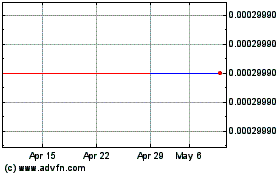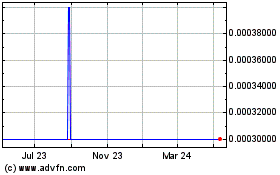Micro Imaging Technology Adds Staph Bacteria to Its Catalog of Identifiers
December 31 2013 - 8:00AM
Marketwired
Micro Imaging Technology Adds Staph Bacteria to Its Catalog of
Identifiers
SAN CLEMENTE, CA--(Marketwired - Dec 31, 2013) - Micro Imaging
Technology, Inc. (OTCQB: MMTC) announced that its MIT 1000 System
can now identify the potentially life-threatening bacteria
Staphylococcus. Staph is one of the five most common
causes of infections after injury or surgery and can lead to very
serious complications with the lung (pneumonia), brain
(meningitis), bone (osteopmyelitis), heart (endorcarditis), and
blood (bacteremia and septicemia). It is also an important food
pathogen. "This is a tremendous step forward for both our
technology and our Company," stated Jeff Nunez, MIT's President and
CEO. "We have not only added another Identifier to our
catalog, but this opens the door for the MIT 1000 Technology to
enter the clinical pathogen detection and identification arena. The
Identifier is available now and will soon undergo AOAC
certification," he continued. Staph can also be contracted through
food contamination, as recently reminded by the USDA's announcement
involving the recall of dried sausage products in San Jose,
California(1). The MIT 1000 is a rapid, bacterial cell-based
detection and identification system that can identify pathogenic
bacteria, now including Staph, in three minutes (average) at half
the cost of the industry average for pathogen tests.
In October 2013, the Company announced that it is collaborating
with the Northern Michigan University (NMU) Department of Biology
to identify and differentiate Staphylococcus aureus
(S. aureus) and the "superbug," Methicillin Resistant
S. aureus (MRSA). The goal of this strategic
research with NMU is to rapidly and cost-effectively identify these
two particular healthcare threats using the MIT 1000
System. Staph infections can range from mild skin problems to
potentially fatal conditions if the bacteria invade deeper into the
body. Most can be easily treated, however, some Staphs are
drug-resistant. The faster the responsible disease causing bacteria
is identified, the faster the appropriate treatment can begin. This
is the driving goal behind the NMU/MIT collaboration using the MIT
1000 to differentiate between the common S. aureus and
MRSA. At this stage, the collaboration involves scientists
from MIT and NMU gathering preliminary data and developing
collaborative research proposals seeking funding in support of
continued research.
Dr. Josh S. Sharp, assistant professor at NMU's Department of
Biology, is directing the NMU research on clinical applications of
the MIT 1000. "Being able to quickly identify if a patient has
an S. aureus infection, and whether or not that S.
aureus is MRSA, a strain of S. aureus resistant to
certain antibiotics, would be extremely useful in dictating the
proper course of treatment for that patient, and ultimately,
increase the likelihood of a successful patient outcome," Sharp
said.
Micro Imaging Technology's Chief Scientist, Dr. David Haavig,
was instrumental in developing the MIT 1000 and is the program
director of the effort and will lead MIT's team in the
collaboration. "This Staph Identifier is a key addition," he said.
"This Staphylococcus Identifier will simplify and speed
the creation of our upcoming S. aureus, Staphylococcus
epidermidis (S. epidermidis) and MRSA Identifiers."
The Staphylococcus Identifier and candidate S.
aureus and S. epidermidis Identifiers and an MIT 1000
System will be delivered to Professor Sharp within the next few
weeks, then he with his graduate and undergraduate students and we
at MIT will begin the preliminary stage of our MRSA collaboration.
Meanwhile, MIT is working on a series of Salmonella Identifiers
including the common food pathogens S. Enteritidis and
S. Typhimurium.
About: Micro Imaging Technology, Inc. Micro Imaging Technology,
Inc. is a California-based public company that is also registered
to do business under the name Micro Identification
Technologies. MIT has developed and patented the MIT
1000, a stand-alone, rapid, optically-based, software driven system
that can identify pathogenic bacteria and complete an
identification test, after culturing, in three minutes (average) at
the lowest cost per test when compared to any other conventional
method. It does not rely on chemical or biological agents,
conventional processing, fluorescent tags, gas chromatography or
DNA analysis. The process requires only clean filtered water
and a sample of the unknown bacteria. Revenues for all rapid
testing methods exceed $5 billion annually - with food safety
accounting for more than $3.5 billion, which is expected to surpass
$4.7 billion by 2015 according to BCC Research. In addition, the
recently passed "New" U.S. Food Safety Bill is expected to further
accelerate the current annual growth rate of 6.6 percent.
In June 2009, the AOAC Research Institute (AOAC RI) awarded the
Company Performance Tested Methods SM (PTM) certification for the
rapid identification of Listeria. The AOAC RI provides an
independent third party evaluation and expert reviews of methods
and will award PTM certification to methods that demonstrate
performance levels equivalent or better than other certified
bacteria identifying methods. The MIT System underwent hundreds of
individual tests, including ruggedness and accuracy, to earn AOAC
RI's certification for the identification of Listeria.
You can find more information about our company and about Micro
Identification Technologies™. Please visit our newly enhanced
website at www.micro-identification.com.
This release contains statements that are forward-looking in
nature. Statements that are predictive in nature, that depend
upon or refer to future events or conditions or that include words
such as "expects," "anticipates," "intends," "plans," "believes,"
"estimates," and similar expressions are forward-looking
statements. These statements are made based upon information
available to the Company as of the date of this release, and we
assume no obligation to update any such forward-looking statements.
These statements are not guarantees of future performance and
actual results could differ materially from our current
expectations. Factors that could cause or contribute to such
differences include, but are not limited to dependence on
suppliers; short product life cycles and reductions in unit selling
prices; delays in development or shipment of new products; lack of
market acceptance of our new products or services; inability to
continue to develop competitive new products and services on a
timely basis; introduction of new products or services by major
competitors; our ability to attract and retain qualified employees;
inability to expand our operations to support increased growth; and
declining economic conditions, including a recession. These and
other factors and risks associated with our business are discussed
from time to time within our filings with the Securities and
Exchange Commission, reference MMTC: www.sec.gov.
(1) December 19, 2013 - Lee Bros. Foodservice Inc., a San Jose,
Calif. establishment, is recalling 740 pounds of sausage products
that may be contaminated with Staphylococcus aureus
enterotoxin, the U.S. Department of Agriculture's Food Safety and
Inspection Service (FSIS) announced today.
CONTACT: Jeffrey Nunez President and CEO Email: Email Contact
Web Site: www.micro-imaging.com Telephone: (949) 388-4546
Micro Imaging Technology (CE) (USOTC:MMTC)
Historical Stock Chart
From Dec 2024 to Jan 2025

Micro Imaging Technology (CE) (USOTC:MMTC)
Historical Stock Chart
From Jan 2024 to Jan 2025
